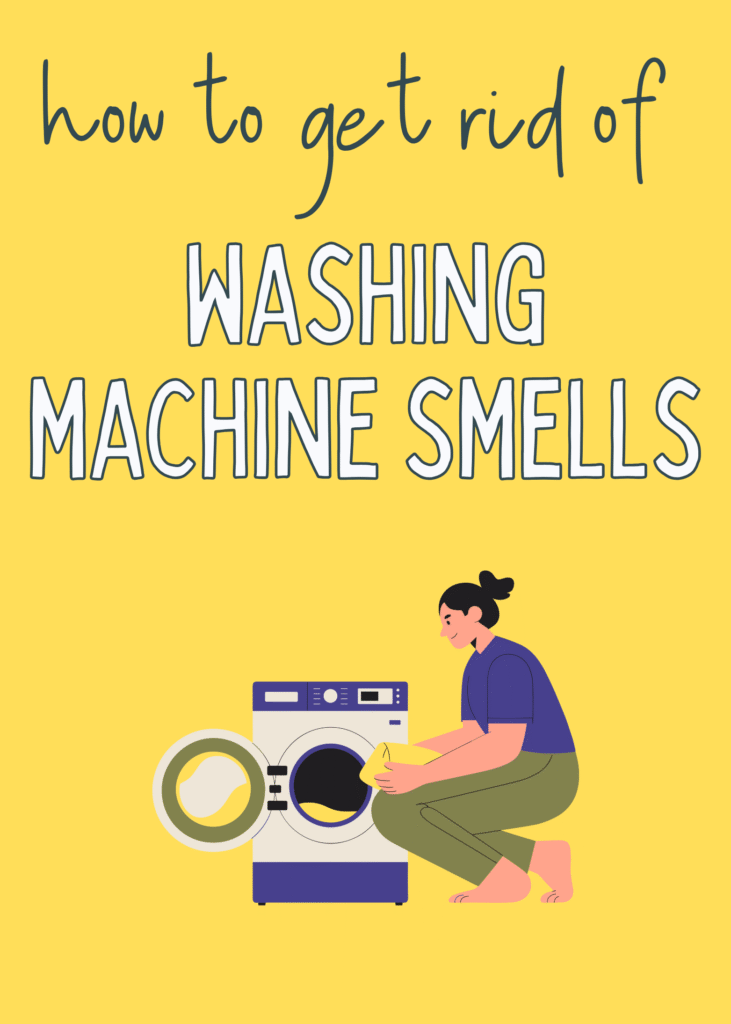* We sometimes use affiliate links, so we may receive a commission, at no cost to you, if you make a purchase through a link. Check our disclosure for more info.
There’s nothing worse than pulling fresh laundry out of the washer, only to notice that the clothes smell damp, musty, or just… off. Washing machines are supposed to make things cleaner, not stinkier. But if your washer smells bad, don’t worry — it’s a common problem and one you can absolutely fix.

In this guide, I’ll explain why washing machines start to smell, the exact steps to get rid of the odour, and how to stop it coming back. I’ll also share a few products that make the job easier and keep your machine fresh.
Why Does a Washing Machine Smell?
Bad smells usually creep up slowly. One day you notice a faint whiff, and before long your whole laundry room stinks. The main culprits are:
Detergent and softener residue
If you use too much detergent or softener, or the wrong kind, it can leave a sticky film inside the machine. That film traps lint and dirt, and before long bacteria start feeding on it.
Trapped moisture
Washing machines — especially front loaders — are designed to seal tightly. That’s great for stopping leaks, but it also means water can sit in the rubber door seal or detergent drawer. Damp + warmth = mold and mildew.
Too many cold washes
Modern detergents work at low temperatures, so lots of us wash at 30 or 40 degrees. But those lower temps don’t always kill bacteria. Over time, the bugs survive and multiply.
Blocked filters or hoses
If your drain filter is clogged with lint, hair, or coins, water can’t flow out properly. Stagnant water quickly starts to smell.
Worn parts
Sometimes old seals, hoses, or even the pump itself harbor grime and bacteria. If you’ve had your machine for years, this might be part of the issue.
People Also Asked…
- How to Save Energy (and Money) in Your Washes
- Washing Machine Smells: Causes & Fixes (with Products)
- Brighten Your Whites: The 5 Best Whitening Boosters for Your Washing Machine
- The Best Tumble Dryers For Large Families
- The Best Washing Lines For Small Gardens
Step-by-Step: How to Get Rid of Washing Machine Smells
Here’s a straightforward routine that works for most people. Give yourself an hour or so to do it properly.
Step 1: Clean the detergent drawer
Pull the drawer right out (most slide out completely). Soak it in hot water with washing-up liquid, then scrub every corner with an old toothbrush. Don’t forget to wipe inside the slot where the drawer sits too.
Step 2: Scrub the door seal
Pull back the rubber gasket around the door and look inside — you’ll probably see slimy black mold, lint, or even coins and hair clips hiding there. Mix equal parts white vinegar and warm water in a spray bottle. Spray the seal, scrub gently with a cloth or brush, and then dry it thoroughly with a clean towel.
Step 3: Run a hot cleaning cycle
Choose the hottest cycle your machine allows (usually 90–95°C) with no clothes inside. Add either half a cup of baking soda in the drum and two cups of white vinegar in the drawer, or use a dedicated machine cleaner (I’ll recommend some below). Let the cycle run in full.
Step 4: Empty the filter and pump
Check your manual to find the filter (usually at the bottom front of the machine). Open it carefully — have a towel or shallow tray ready, as water often spills out. Remove any lint, coins, or fluff. Give it a rinse under the tap before putting it back.
Step 5: Wipe everything down
When the hot cycle finishes, wipe the drum, door, and inside edges dry. Then leave the door and drawer open for a few hours to air out.
How to Stop the Washing Machine Smell Coming Back
Once you’ve given your washer a deep clean, the key is prevention. A few simple habits make a huge difference:
- Use the right amount of detergent. More soap doesn’t equal cleaner clothes — it just leaves gunk behind.
- Don’t overdose fabric softener. It’s basically waxy residue in liquid form.
- Mix in some hot washes. Even if you normally wash at 30°C, throw in a 60°C or 90°C cycle once in a while to kill bacteria.
- Ventilate. Leave the door and drawer ajar after each wash to let air circulate.
- Wipe the seal. Quickly running a cloth around the gasket after each wash helps stop mold from forming.
- Clean the filter regularly. Once every month or two is usually enough.
Products That Actually Work
Home remedies like vinegar and baking soda work well for maintenance, but sometimes you need something stronger. Here are some tried-and-tested products that target smells and grime:
1. Dr Beckmann Service-It Washing Machine Cleaner
A classic choice in the UK. It cuts through detergent residue and limescale. Use it once a month for best results.
2. Dettol Washing Machine Cleaner (Lemon Scent)
Not only does it clean the drum and pipes, but it leaves a fresh lemon smell. A good option if your washer smells musty.
3. Ecozone Washing Machine & Dishwasher Cleaner
An eco-friendly formula that avoids harsh chemicals. Great if you want to clean effectively while staying green
4. HG Service Engineer Washing Machine Cleaner
This one’s a heavy-duty cleaner designed to shift stubborn grease and bacterial buildup. Ideal if smells keep coming back.
5. Vamoosh Washing Machine Cleaner
A powdered cleaner that’s great at removing hair and lint buildup. Especially useful for households with pets.
Common Washing Machine Smells and What They Mean
- Musty / mouldy: Probably mildew in the seal or drawer.
- Sour / damp clothes smell: Detergent residue feeding bacteria.
- Eggy / sulphur smell: Drainage issue — check the hose or plumbing.
- Chemical smell: Too much detergent or leftover cleaning products.
A Simple Monthly Routine
Here’s a routine that keeps your machine fresh:
Week 1: Run a hot cycle with a machine cleaner.
Week 2: Wipe the door seal and drawer.
Week 3: Clean the filter.
Week 4: Do nothing — enjoy the break!
This way, you’re only spending a few minutes a week, but your washer stays fresh all year.
When to Call in Help
If you’ve cleaned everything and the smell still won’t shift, it could be:
- A plumbing problem (sewer smells coming up through the drain).
- A failing part inside the machine (pump, hose, or gasket).
- A deeper mould issue in the walls of the drum.
In that case, it’s worth calling a repair engineer. Sometimes replacing an old gasket or hose is all it takes.
A smelly washing machine doesn’t mean you need a new one. In most cases, it just needs a good clean and a bit of regular care. By tackling the detergent drawer, gasket, drum, and filter — and using a reliable cleaner once a month — you’ll get rid of the stink and stop it coming back.
If you want my top pick, I’d go with Dr Beckmann Service-It for routine cleaning, and keep a bottle of Dettol Lemon Cleaner handy for quick refreshes.
With just a little effort, your washer will smell fresh, your clothes will come out clean, and laundry day won’t be ruined by that unpleasant musty odour again.
